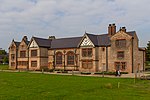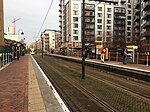Trafford Bar tram stop
1849 establishments in EnglandFormer Manchester, South Junction and Altrincham Railway stationsPages with no open date in Infobox stationRailway stations in Great Britain closed in 1991Railway stations in Great Britain opened in 1849 ... and 6 more
Railway stations in Great Britain opened in 1992Tram stops in TraffordTram stops on the Altrincham to Bury lineTram stops on the Altrincham to Piccadilly lineTram stops on the East Didsbury to Rochdale lineUse British English from August 2017

Trafford Bar is a tram stop on Greater Manchester's light rail system, Metrolink, at the junction of Talbot Road and Seymour Grove in Old Trafford. It opened on 15 June 1992 as part of Phase 1 of Metrolink's expansion, before which it was a mainline railway station.
Excerpt from the Wikipedia article Trafford Bar tram stop (License: CC BY-SA 3.0, Authors, Images).Trafford Bar tram stop
Elsinore Road, Trafford Wharfside
Geographical coordinates (GPS) Address Nearby Places Show on map
Geographical coordinates (GPS)
| Latitude | Longitude |
|---|---|
| N 53.46169 ° | E -2.2774 ° |
Address
Trafford Bar
Elsinore Road
M16 0WH Trafford, Wharfside
England, United Kingdom
Open on Google Maps









